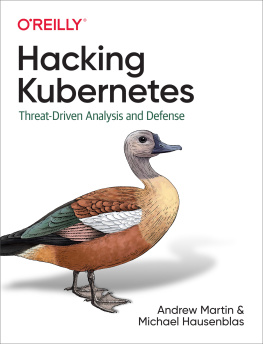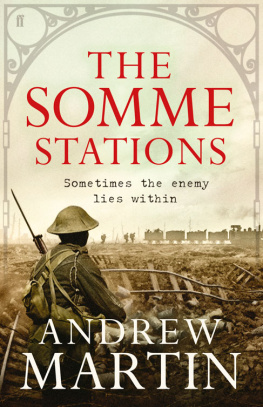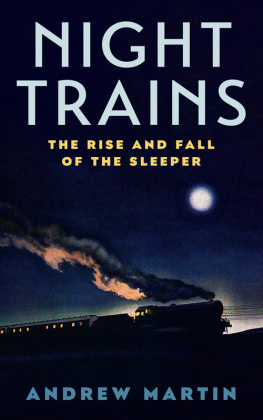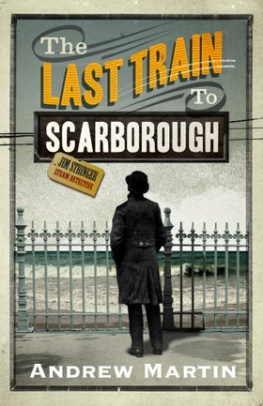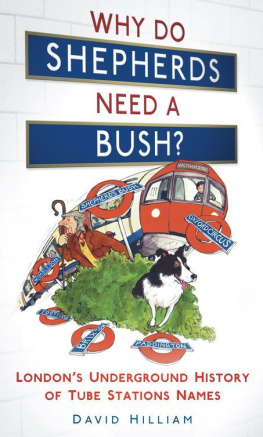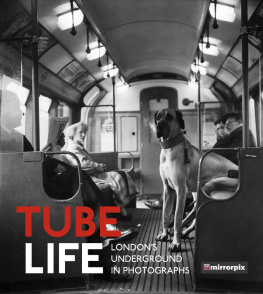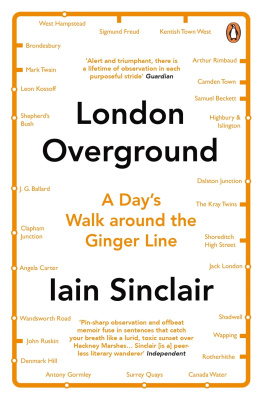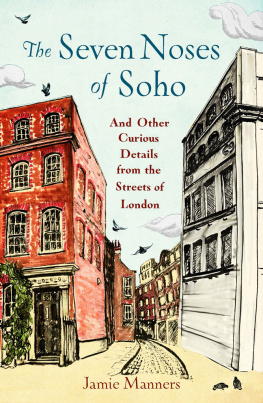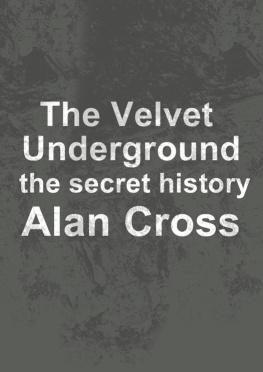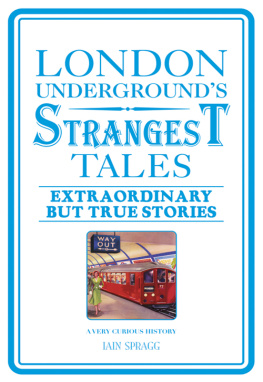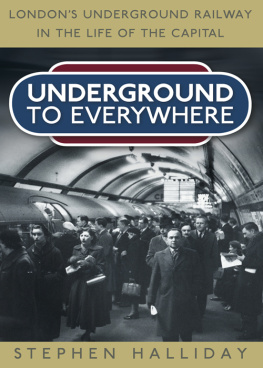UNDERGROUND OVERGROUND
ALSO BY ANDREW MARTIN
NOVELS
Bilton
The Bobby Dazzlers
The Jim Stringer Series:
The Necropolis Railway
The Blackpool Highflyer
The Lost Luggage Porter
Murder at Deviation Junction
Death on a Branch Line
The Last Train to Scarborough
The Somme Stations
The Baghdad Railway Club (forthcoming)
NON-FICTION
Funny You Should Say That: Amusing Remarks from Cicero to The Simpsons (editor)
How To Get Things Really Flat: A Mans Guide to Ironing, Dusting and other Household Arts
Ghoul Britannia: Notes From a Haunted Isle
UNDERGROUND OVERGROUND
A PASSENGERS HISTORY OF THE TUBE
ANDREW MARTIN

First published in Great Britain in 2012 by
PROFILE BOOKS LTD
3A Exmouth House
Pine Street
London ECIR OJH
www.profilebooks.com
Copyright Andrew Martin, 2012
The Burial of the Dead taken from The Waste Land Estate of T.S. Eliot and reprinted by permission of Faber and Faber Ltd
1 3 5 7 9 10 8 6 4 2
Designed by Geoff Green Book Design, Cambridge
Typeset in Jenson by MacGuru Ltd
info@macguru.org.uk
Printed and bound in Great Britain by
Clays, Bungay, Suffolk
The moral right of the author has been asserted.
All rights reserved. Without limiting the rights under copyright reserved above, no part of this publication may be reproduced, stored or introduced into a retrieval system, or transmitted, in any form or by any means (electronic, mechanical, photocopying, recording or otherwise), without the prior written permission of both the copyright owner and the publisher of this book.
A CIP catalogue record for this book is available from the British Library.
ISBN 978 1 84668 477 7
eISBN 978 1 84765 807 4
The paper this book is printed on is certified by the 1996 Forest Stewardship Council A.C. (FSC). It is ancient-forest friendly. The printer holds FSC chain of custody SGS-COC-2061

A NOTE ON THE TITLE
On London Underground, there are the cut-and-cover lines running just below the surface, and the Tubes properly so-called, which are on average about 40 feet down. But Tube is now used as shorthand for the whole network, not least by London Underground itself, as in Upgrading Your Tube; and it is used to mean the whole network in the title of this book. It tends to be older Londoners who hold on to the distinction. A friend of mine was visiting his mother who lives about 500 yards from Parsons Green station on the District, which is a cut-and-cover line. At the end of the evening she said, How are you getting back? He said, Oh, on the Tube, and she looked at him absolutely blankly. What Tube? she said. There is no Tube here. To her and to all other sticklers for the distinction I apologise, and I offer in mitigation the fact that my title does take note of the paradox that seems to embody the overall perversity of the Underground: 55 per cent of it is on the surface.
CONTENTS
PREFACE
DAD, IM OFF TO LONDON
I have always been keen on the London Underground, even though I was born in Yorkshire. I was like Richard Larch in A Man from the North (1898), by Arnold Bennett: There grows in the North Country a certain kind of youth of whom it may be said that he is born to be a Londoner. The metropolis, and everything that pertains to it, that comes down from it, that goes up into it, has for him an imperious fascination.
My father worked on British Rail, and I had free first-class train travel on the national rail network in the form of a Privilege Pass. I also had free travel on the London Underground, which seemed almost indecent, given that my dad did not work for the Underground and that I came from 250 miles north of London. If at all bored in York, Id say, Dad, Im off to London, and Id collect up my Priv Pass and a handful of the privilege Underground tickets that were usually lying about the house. (Whereas normal Underground tickets in the Seventies were made of green card, the privilege tickets were green and white card special, you see.) Well, dont lose your Pass, or Ill get sacked, my dad would say.
London wore me out. But then I had a very exhausting method of traversing the city, which involved pinballing about from one public street map to another. In theory you could work out your route by pressing buttons that illuminated little light bulbs, but the You Are Here part had always been carefully vandalised, and without that you might have been anywhere. So Id take the Tube, because the Tube map I could understand. But precisely because it is schematic rather than geographically accurate, with the central area magnified for clarity so that the distance between Archway and Highgate on the Northern Line, which is about a mile, is shown as being less than the distance between Piccadilly Circus and Leicester Square on the Piccadilly Line, which is about 800 feet I would take journeys I didnt need to take, for example from Piccadilly Circus to Leicester Square, which is the shortest trip possible on the Underground. When in doubt take the Underground, urged an early Underground poster showing a bewildered little bowler-hatted man with an illuminated Underground sign behind him. That little man was me.
The Underground was my ally in London. I was the son of a railwayman, and what was the Underground but an incredibly high concentration of railways? Also it offered a key to the city so maybe I wouldnt get off at Leicester Square. I might stay on all the way to Manor House, where I would step out and have a walk around, always keeping Manor House station in sight, just as Doctor Who keeps the Tardis in sprinting range when he lands on a new and possibly dangerous planet. I would travel to a place on the slightest of motivations, to find things out. Was there a Manor House at Manor House? (No, only a pub called The Manor House.) Was there a hill at Gants Hill? No; that would be almost as naive as expecting a hill at Dollis Hill. (There isnt even an apostrophe at Gants Hill, a deficiency it shares with Parsons Green but not Earls Court. But by way of compensation, there is a beautiful Underground station.)
In my boyhood, the system was not what it had been in the triumphalist inter-way heyday, and nor was it like the spruce, sparkling (if badly overcrowded), upgraded Underground of today. In the Seventies the system was run-down and demoralised. Road transport was the future; the Underground was being managed for decline, and the system was filthier even than the streets above. You were not to lean against the station walls, or that was your rally jacket ruined. In most of the stations about a quarter of the tiles would be broken. Sometimes the station name was meant to be spelled out by tiles, and Londoners toleration of the position at, say, Covent Garden rendered for years as something like COVT GDEN implied an impressive broad-mindedness on their part.
You could actually see the atmosphere in the stations: it was sooty, particulate. There is an Underground poster from the late Thirties by Austin Cooper that advertised something as unmysterious as Cheap Return Tickets but did so with an abstract image: a lonely searchlight trying to penetrate a jaundiced miasma. That was the Underground of my boyhood: a marvel of engineering but also a dream space, in which people of all classes and races would float past you, with the strange buoyancy of a passing carriage. In the case of the people in your own carriage (or car, since the Underground is riddled with American railway terminology), you could look at them directly, or you could look at their reflections in the windows, and they would be sunk in their own dreams; all this under electric light, so that it always seemed as it always still
Next page

